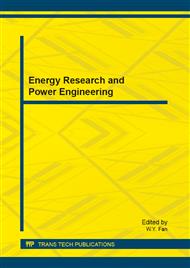[1]
Chen Qixin, Kang Chongqing, Xia Qing. Key low-carbon factors in the evolution of power decarbonisation and their impacts on generation expansion planning[J]. Automation of Electric Power Systems, 2009, 33(15): 18-22.
Google Scholar
[2]
Srivastava S, Sravastava A, Rout U, et al. Least cost generation expansion planning for a regional electricity board in India considering green house gas mitigation[J]. PowerCon on power system technology, Singapore, (2000).
DOI: 10.1109/icpst.2000.900027
Google Scholar
[3]
Doherty R, Outhred H, O'Malley M. Generation portfolio analysis for a carbon constrained an uncertain future international conference on future power systems[J]. Amsterdam, (2005).
DOI: 10.1109/fps.2005.204266
Google Scholar
[4]
Liang Qiaomei. The energy complex system modeling and energy policy analysis system[M]. Beijing. Chinese academy of sciences, (2007).
Google Scholar
[5]
Lee TY. Optimal spinning reserve for a wind-thermal power system using EIPSO[J]. IEEE Trans on Power Systems, 2007, 22(4): 1612-1621.
DOI: 10.1109/tpwrs.2007.907519
Google Scholar
[6]
Yu a w. Planning wind power considering system reliability in peak demand time. IEEE PES general meeting. Pittsburgh, (2008).
DOI: 10.1109/pes.2008.4596158
Google Scholar
[7]
Yuan Jiandang, Yuan Tiejiang, Chao Qin. Power planning study on a large scale wind power integrated system under power market[J]. Power system protection and control, 2011, 39(5): 22-26.
Google Scholar
[8]
Kang Longyun, Guo Hongxia, Wu Jie. Research projects reviews of distributed power supply and its connection to the power system [J]. Power System Technology, 2010, 34(11): 43-47.
Google Scholar
[9]
Wang H, Toshihiko N. Analysis of the Market Penetration of Clean Coal Techinologies and Its Impacts in China's Electricity Secto[J]r. Energy Policy, 2009, 37(1): 338-351.
DOI: 10.1016/j.enpol.2008.09.045
Google Scholar
[10]
Broek M, Faajj A, Turkenburg W. Planning for an Electricity Sector with Carbon Capture and Storage—Case of the Netherlands[J]. International Journal of Greenhouse Gas Control, 2008, 2(1): 105-129.
DOI: 10.1016/s1750-5836(07)00113-2
Google Scholar
[11]
Chen Qixin, Kang Chongqing, Xia Qing. Application of carbon capture technology to power system and its change [J]. Automation of Electric Power Systems, 2010, 34 (1): 1-7.
DOI: 10.1109/pes.2010.5588048
Google Scholar
[12]
Chen Qixin, Zhou Tianrui, Kang Chongqing, et al. An assessment model of low-carbon effect and its application to energy saving based generation dispatching[J]. Automation of Electric Power Systems, 2009, 33(16): 24-29.
DOI: 10.1109/powercon.2012.6401256
Google Scholar
[13]
Chen Qixin, Kang Chongqing, Xia Qing. Key low-carbon factors in the evolution of power decarbonisation and their impacts on generation expansion planning[J]. Automation of Electric Power Systems, 2009, 33(15): 18-22.
Google Scholar
[14]
Kang Chongqing, Zhou Tianrui, Chen Qixin, et al. Assessment model on low-carbon effects of power grid and its application[J]. Power System Technology, 2009, 33(17): 1-7.
DOI: 10.1109/powercon.2012.6401256
Google Scholar
[15]
LU Zhigang, CHENG Huilin, ZHANG Jing and SUN Jikai, A Method for Switch Information Error Identefication Based of Improved Discrete Bacterial Colony Chemotaxis Algorithm, Automation of Electric Power System, 2012, 36(12): 55-60.
Google Scholar


